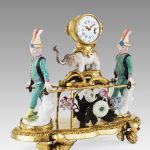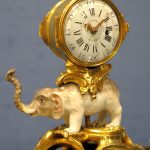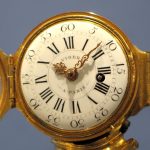The Marquis Clermont d’Amboise’s elephant clock
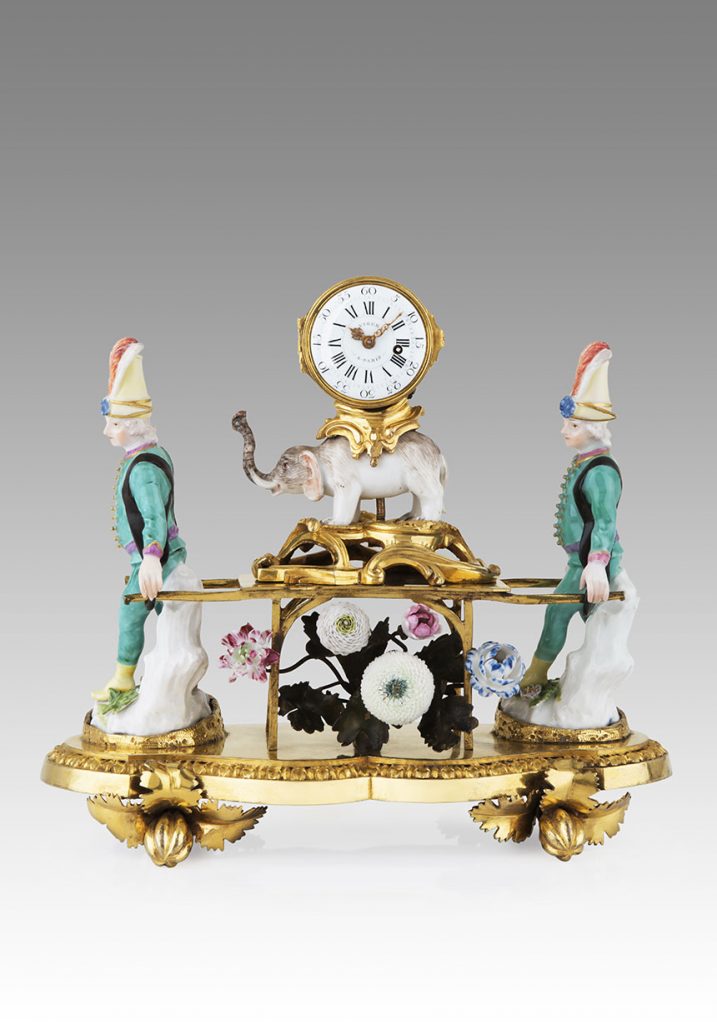
A Louis XV gilt bronze and Meissen porcelain mantel clock in the form of an elephant carried on a palanquin by two servants,
the dial signed Viger à Paris,
the watch movement signed Viger à Paris N° 1184 – circa 1750
The porcelain modelled by Peter Reinicke
François Viger (1708-1784, master 1744)
Height: 17.5 cm. (7 in.) Width: 20 cm. (8 in.) Depth: 10 cm. (4 in.)
Provenance
Listed in Marquis Clermont d’Amboise’s inventory after his death on 26 October 1761
Comparative Literature
A similar clock in the form of a jardinière filled with flowers carried on a palanquin by two servants is illustrated in Partridge Exhibition Catalogue, 1997, fig. 34.
The Marquis Clermont d’Amboise undoubtably bought this fanciful clock from a Parisian marchand-mercier who had ordered the porcelain from the Meissen factory. It is described very precisely in the Marquis’s post-mortem inventory on 26 October 1761:
Un petit cartel à cadran d’émail dans sa boite de cuivre doré d’or moulu posé sur un éléphant soutenu d’une terrasse de cuivre doré d’or moulu et porté sur un brancard de pareil cuivre par deux figures de porcelaine de saxe le tout posé sur un pied de cuivre d’or moulu
(A small cartel clock with an enamel dial in a gilt bronze casing placed on an elephant supported by a gilt bronze terrace and carried on a stretcher of the same bronze by two figures of Meissen porcelain, the whole placed on a gilt bronze base)
The refined sophistication of 18th century French interior decoration comes about through the close collaboration between the marchands-merciers and a veritable network of Parisian artisans with unparalleled savoir-faire.
Under Louis XV in Paris, the powerful corporation of marchands-merciers constantly invented new luxurious objects for a wealthy clientele eager for unique pieces and innovative taste. These rare clocks adorned with Meissen porcelain are magnificent testimonies to the boundless imagination of these French merchants. Truly designers in the modern sense, they had the idea of combining clock-making with gilt bronze and Meissen porcelain which was particularly popular with great amateurs in the early part of Louis XV’s reign.
The fashion for porcelain flowers soon prompted the marchands-merciers to incorporate them as well in all sorts of forms: not only clocks but fountains, candelabras and candlesticks, potpourris, bird cages, chandeliers, lanterns and inkstands. Rapidly, a few reputable merchants specialised in these items adorned with delicate porcelain flowers initially from Meissen itself or soon after from the recently established factory at Vincennes then Sèvres.
One of them, Michel-Joseph Lair (1732-1759), recorded at rue du Roule under the sign of Le Roy des Indes, was a “privileged merchant and ceramicist (faïencier) to the King”. Many items of Meissen porcelain remained in his stock at the time of his death, including several clocks fitted, as here, with watch movements, foliage and Meissen porcelain figures. He was the proud owner of the imposing clock now in the Petit Palais in Paris, then described as: “a masterpiece of a large clock garnished with an organ, mounted in gilded copper and ornamented with Meissen porcelain flowers and sixteen Meissen porcelain figures” and priced at the large sum of 2,000 livres.
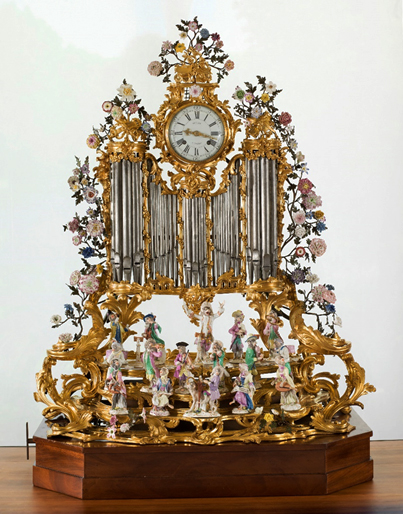
Organ clock with a monkey concert in Meissen porcelain and gilt bronze, movement by Jean Moisy – circa 1755
Height: 130 cm. Width: 85 cm.
Paris, Petit Palais (inv. ODUIT 1790)
Edme Choudard-Desforges was another faïencier in the Meissen porcelain trade also located in the rue du Roule. The inventory of his store, drawn up in December 1759, lists a quantity of porcelains from Saxony (as Meissen was known in the 18th century), some of which are richly mounted, as well as a few clocks supported by various porcelain subjects. Based in the rue Saint-Honoré, Jacques-François Machart (active 1744-1763) enjoyed a prestigious clientele and presented in his shop elegant objects of art in Meissen porcelain magnificently mounted in gilt bronze. Machart employed the best Parisian workshops of bronziers and gilders. When he went bankrupt in 1763, several clocks are recorded featuring Meissen porcelain subjects.
Finally, there is Lazare Duvaux (ca. 1703-1758) – undoubtedly the most famous Parisian marchand-mercier – who was based in rue Saint-Honoré under the sign of the Chagrin de Turquie. Duvaux counted among his clients Louis XV and Madame de Pompadour, all the high aristocracy and the circle of powerful financiers. His business was prosperous and the purchases of his many customers are known from the famous “livre-journal du marchand bijoutier ordinaire du Roy“, which still survives.
Several more or less elaborate clocks adorned with Meissen porcelain are cited in this stock book between 1748 and 1758: one was invoiced for 900 livres on 16 October 1749 to the banker Camuset: “A clock on a Meissen dog, furnished with plants and flowers from Vincennes on the terrace and ornaments in gilt bronze”; one sold to Mme de Pompadour on 11 June 1751, with a “group of Meissen porcelain, mounted on a gilt bronze terrace and branches, the flowers of Vincennes, the movement simple” at 490 livres. On 21 January 1754, the Chevalier Lambert bought “a clock on a gilt bronze terrace and other ornaments, on a Meissen group, with varnished brass branches imitating nature, adorned with very beautiful Vincennes flowers” for 830 livres. On 16 December 1755, Mme de Pompadour received “a clock with Meissen figures, very ornate, mounted in bronze with flowers” for the large sum of 1,800 livres.
Unfortunately, it is difficult to match most of these descriptions with the examples that survive today, making it impossible to identify the marchand-mercier who created these fascinating orders. Thus, the clocks decorated with Meissen porcelain still reveal only a tiny part of their mysterious history.


